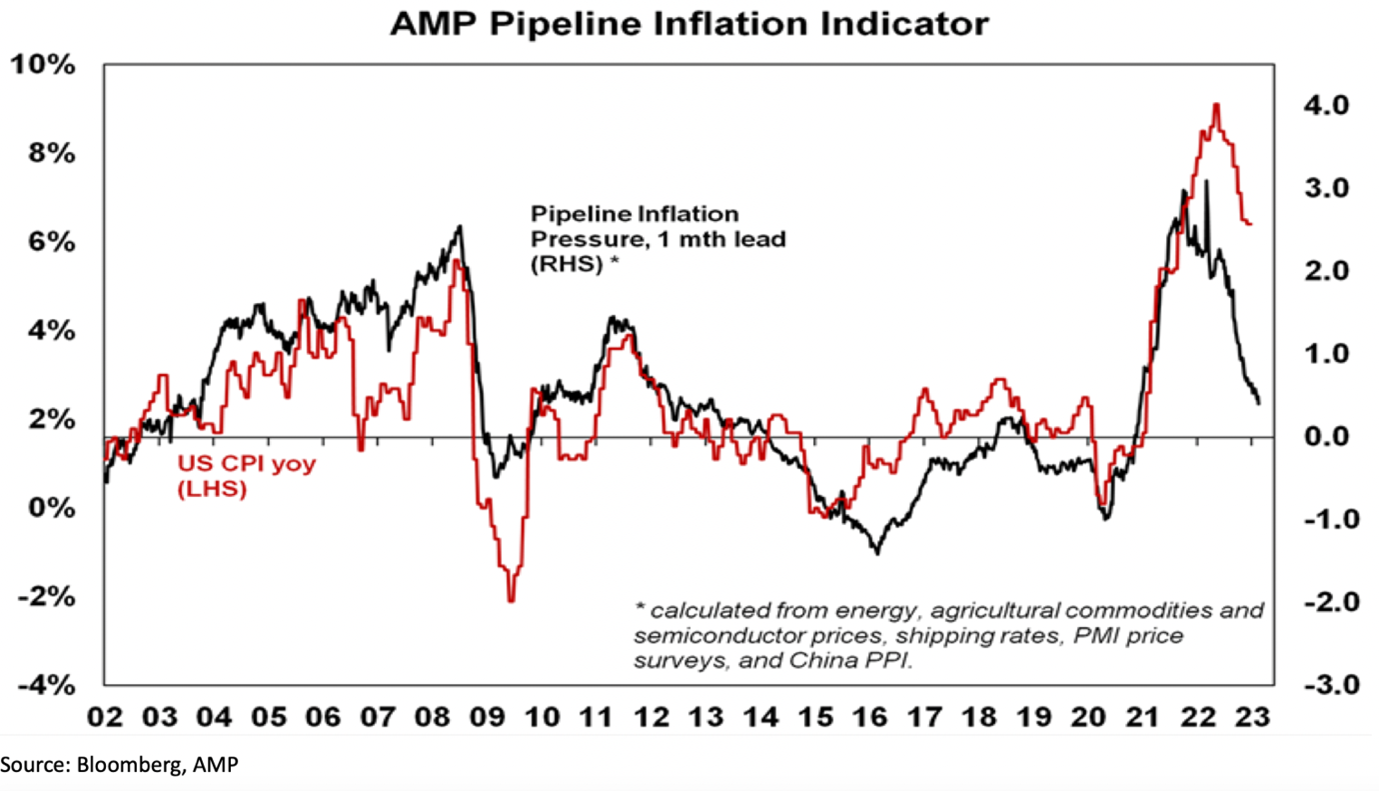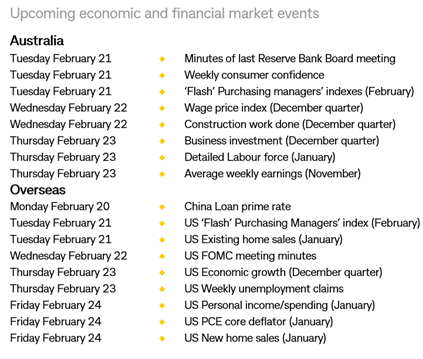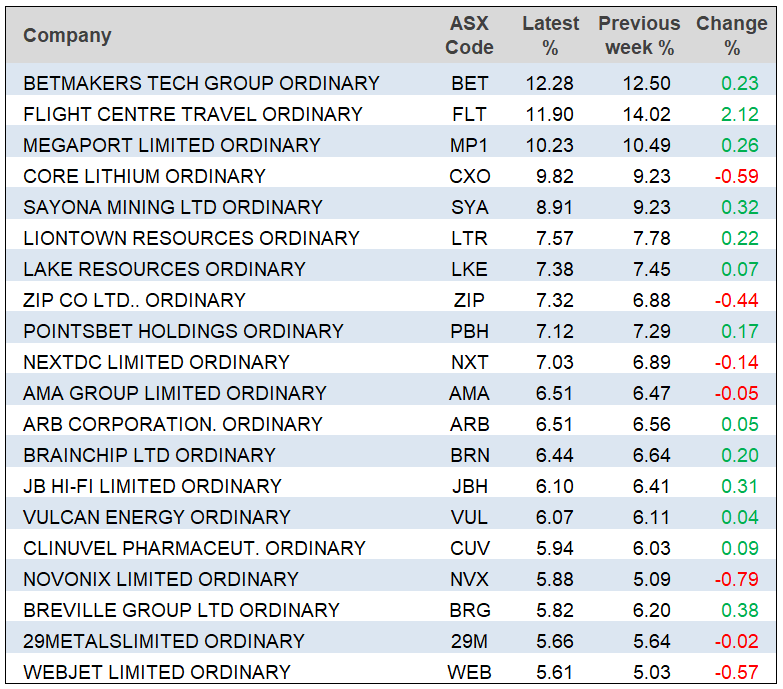
Last year was dominated by persistent pessimism but this week showed that possibly over-the-top optimism is the investing theme for 2023. To be more accurate, I think the longer-term believers, who think that interest rates will peak and tech/growth stocks will stage a comeback, are outweighing the short-term traders. The latter think the run of economic data is screaming that the interest rate peak is further way than was thought last week and the month before, so they’d be selling now to make money. But the tech-believers must be buying.
What could tip the balance is the move in US bond market interest rates, which had been falling when we saw the great start for stocks in January, with the S&P 500 up a whopping 6.2% for the month. And showing the importance of tech stock re-loving, the less tech-heavy Dow Jones index was only up 2.8%.
Want more proof that tech lovers are believers? Well, note the Nasdaq was up 10.7% in January, and as the old saying reminds us: “As goes January, so goes the year.”
US market statistician and historian, Sam Stoval at CFRA, has revealed: “Since World War II, if the market is up in January, it has continued to rise in the remaining 11 months of the year more than 85% of the time and average gain is about 11.5 %.”
And if the S&P 500 can register an 11.5% gain this year, I bet the Nasdaq will easily top that figure. And I’m not alone in believing that analysis. That’s why it took nearly all week for the US and local stock markets to turn negative.
Of course, this shouldn’t surprise us because both the Fed’s Jerome Powell and the RBA’s embattled Dr Phil Lowe have warned us that interest rate rises and their peak will be determined by the economic data drops. And this week was no help.
The US consumer price index rose 0.5% for the month, translating into an annual gain of 6.4%. The increase was slightly higher than economists estimated and then retail sales surged 3% in January, which followed a 1.1% drop in December. Surveys by economists pointed to a 2% rise and while this lifted interest rate rise concerns, it lowered recession fears for the world’s biggest economy and most important stock market.
This probably explains why stocks were only down around 1% for the week ahead of the Friday close but it does remind us that data is going to be critically important for what central banks do and then what happens to stock prices. And as I’ve said, bond markets will be important to watch. “We have been in a very contentious tug of war between the equity markets and the treasury markets,” Art Hogan, chief market strategist at B.Riley told CNBC. “While Treasuries are signalling that the Fed is going to hold rates higher for longer, equities are not listening and instead are looking for a soft landing. Equity investors seem to be looking through a couple more rate hikes and looking forward to a pause.”
I’m realistic about the run of data that hasn’t been good for those hoping inflation will fall quickly and it really started with the unbelievable 517,000 jobs created in the US in January. Then inflation and retail sales numbers said to us: “You better believe inflation isn’t going to fall as fast as market optimists would like”.
However, data has a habit of making a monkey out of a lot of ‘expert’ forecasters and this could explain why the sell-off has been controlled. This inflation graph from AMP’s Shane Oliver and his take might explain a bit of the market optimism.

And this is what Shane said about his graph: “While a rebound in US retail sales coming on the back of strong January payrolls will likely keep the Fed on edge for a while yet, we remain of the view that it’s getting close to the peak in the Fed Funds rate.”
For stocks this year, he added: “Global shares are expected to return around 7% and Australian shares are likely to outperform again, helped by stronger economic growth than in other developed countries and, ultimately, stronger growth in China, supporting commodity prices.”
To the local story and the S&P 500 lost 86.9 points (or 1.17%) for the week to finish at 7346.80. This wasn’t bad considering the data this week said inflation isn’t falling as fast as we expected both in the US and here, which should have been worse for stock prices.
That said, tech companies did bear the brunt of the view that the peak of the interest rate rise cycles in both the US and here isn’t great for growth businesses.
Wisetech fell 3.55% to $56.54 on Friday but it was for good reasons after buying Blume Global for $US414 million. Megaport lost 2.48% on Friday after the US data wasn’t good to ‘rate rise peaking’ hopes, but it was up 7.9% for the week. That’s a preview of what happens when interest rate rises are over.
Here were the big winners and losers:

Star (SGR) copped it after warning of an up to $1.6 billion impairment charge in first-half earnings from a proposed casino duty hike in New South Wales, sending its shares tumbling 22% to a record low. Meanwhile, AMP might have paid a dividend, at long last, but the market didn’t like the fall in the underlying NPAT. That said, the company implied the worst of its headwinds are behind it. It should be remembered that its share price rose 30% in 2022 as it unlocked value for shareholders through divestments.
Meanwhile, the bad news for BNPL companies continues, with ASIC demanding tougher regulations for the sector. Afterpay’s Block Inc. dropped 7.76% on Friday, while Zip Co lost 2.5%.
What I liked
- Unemployment rose from 3.5% to 3.7%, which might help slow down the RBA’s rate rises. Some 11,000 jobs were lost and it was the second consecutive monthly fall in seasonally adjusted employment.
- Monthly overseas arrivals data points to a continuing surge in net immigration to Australia. This will add to demand in the economy but it will also help reduce the tight labour market.
- Shane Oliver of AMP says: “Our US Pipeline Inflation Indicator continues to point to a further sharp fall in inflation ahead…” for the US. Inflation down and the end of US rate rises will spark stock price surges.
- Short-term inflation expectations continue to fall in the US from recent highs and 5–10-year inflation expectations are in the range they’ve been in for the last few decades, suggesting inflation expectations remain “well anchored”. This means the Fed’s task in getting inflation down should be far easier than in the early 1980s.
- CoreLogic data so far for February shows a sharp slowing in home price falls, with Sydney prices up slightly. This begs the question whether the cycle is now turning up again, but you must be careful about short-term data surprises.
- The January NAB business confidence and business conditions both rose, with the latter was up from 13 to 18 while the former — confidence — spiked from 0 to 6. While these were both good signs, they were recorded before the RBA’s latest rate rise and very hawkish commentary.
- AMP’s Economic Activity Trackers rose in the US, were unchanged in Europe (which is good for recession worriers) and fell in Australia last week (which again is good for inflation and interest rate worriers).
- Signs the US is close to the last rate rise showed up in industrial production, which was flat in January, small business optimism that remained weak, while manufacturing conditions in the Philadelphia region fell sharply and housing starts fell.
- US company earnings suggest that interest rate rises are working to slow the economy down. With 80% of US companies in the S&P 500 having already reported their profits, only 68% of results have come in better than expected, which is below the norm of 76%.
What I didn’t like
- The Consumer Price Index (CPI) rose by 1.9% in the December quarter after a 1.8% rise in the previous quarter. The annual inflation rate lifted from 7.3% to 7.8%. The underlying rate (i.e., the trimmed mean) rose by 1.7% in the quarter and 6.9% on the year. The alternate ‘underlying’ weighted median rose 1.6% in the quarter and 5.8% on the year.
- The Westpac/Melbourne Institute consumer sentiment index fell by 6.9% in February and sits just above the November low of 78.5. The RBA must be careful about too many more rate hikes.
- The NAB business survey did show that purchase costs rose to 3.2% in quarterly terms (was 2.6%), labour costs rose to 2.7% (was 2.1%) and output price growth rose to 1.7% (was 1.5%). These aren’t good revelations for lower inflation.
- The January HIA survey of home builders shows that new home sales fell another 13% and they’re running around half what they were a year ago.This is another sign that says the RBA must be cautious about too many more rate rises.
- January retail sales in the US surged 3%, which makes me worry that the US consumer’s excessive shopping habits will force the Fed to lift rates by 0.5% to give the Yanks a scary hike in their interest rates.
- UK inflation is still too high at 10.1% and 5.8% for the core, but it is falling, which adds to signs that inflationary pressures have peaked globally.
Why the RBA must be careful
This graph of NAB’s business confidence and conditions readings shows how negative attitudes were in January. The lagged effects of too many interest rate rises could mean we might see a bigger-than-expected drop in inflation sooner than Dr Phil is guessing.

And when it comes to inflation-killing with interest rates, for all economists, no matter how good their training, it’s a guessing game!
The week in review:
- In this week’s Switzer Report, I talk abut what will make or break this market and what socks are looking hot for 2023! How you want to play investing from here could be determined this week, with the US set to see its latest CPI number for January.
- Paul Rickard tells you why big LICs are still a sell, and there are better alternatives. Paul has never understood why an investor would pay $1.20 for something that is worth $1.00. This is what happens when investors choose to invest in listed investment companies trading at a premium to their NTA (net tangible asset value).
- Tony Featherstone shows you two affordable housing stocks that he thinks will be worth watching! Here are two companies with successful models for providing housing for downsizing retirees.
- James Dunn discuss 4 biotechs with major news coming this year, the fact of biotech investing is that the share prices are at the mercy of news flow from drug trial results, partnerships with bigger companies, regulatory interactions and a wide range of other events that can point to the increased – or decreased – likelihood of the drug, medical device or diagnostic test ever reaching the market.
- In our “HOT” stock column today, Raymond Chan, Head of Asian Desk at Morgans explains why he says to add Macquarie Bank (MQG) to your portfolio. Plus Michael Gable, Managing Director of Fairmont Equities, says that the chart for Orica (ORI) is reflecting the potential for further upside.
- In Buy, Hold, Sell – Brokers Say, there were 11 upgrades and 22 downgrades in the first edition and 11 upgrades and 8 downgrades in the second edition.
- And finally, In Paul Rickard’s Questions of the Week, If you bought CBA shares this week, will you be eligible for the dividend, and how do you participate in the buy-back? Will CBA shares under the DRP be issued at a discount, and can you still change my participation? Is JB Hi-Fi a sell? What are the broker targets for Pilbara Minerals?
Our videos of the week:
- Jun Bei Liu’s top 3 stocks for 2023! And Marcus Bogdan on dividend stocks for the year ahead | Switzer TV
- Why RBA boss Dr Phil will cop it in Canberra this week! | Switzer Daily
- Accountant Fraudster take wealthy for a $60M ride! | Switzer Daily
- Rates to rise and Dr Phil wont resign! | Switzer Daily
- Boom! Doom! Zoom! | 16th February 2023
- ATO to tax work-from-homers harder and US inflation hitting stocks, again!?! | Switzer Daily
Top Stocks – how they fared:

The Week Ahead:

Food for thought: “Sometimes buying early on the way down looks like being wrong, but it isn’t.” – Seth Klarman
Stocks shorted:

ASIC releases data daily on the major short positions in the market. These are the stocks with the highest proportion of their ordinary shares that have been sold short, which could suggest investors are expecting the price to come down. The table shows how this has changed compared to the week before.
Chart of the week
Employment fell by 11,500 in January 2023. This was a big downside surprise. The consensus of market economists had expected a lift in employment of around 20,000. Instead, the decline in January marks the second consecutive monthly fall and follows a 20,000 decline in December (downwardly revised from -14,600 previously).
The fall in employment reflected a large 43.3k decline in full-time employment that more than offset the 31.8k rise in part-time employment. Full-time employment had driven the increase in employment over 2022 as those previously working part-time shifted into full-time work.
The unemployment rate rose to 3.7%. The unemployment rate is the key statistic in today’s release from a monetary policy standpoint. Since reaching a near 50-year low in October 2022 of 3.4%, the unemployment rate has increased in each subsequent month.

Today’s labour force data is a further sign of a cooling in the labour market. Put another way, the labour market is slowly loosening. Job ads and vacancies have been declining for several months, a sign of retreating labour demand. That said, it’s hard to be conclusive yet given difficulties with changing seasonal patterns and tentative data showing a bounce may occur in February.
Nevertheless, it may well prompt the RBA to reassess their outlook for the labour market, and by extension the future path of monetary policy tightening. The RBA’s latest forecast, released last Friday, sees the unemployment rate reaching 3.8% by December quarter 2023.
The unemployment rate has started 2023 just 0.1 percentage points away from that, and there are only headwinds to the labour market from here. There will need to be a full reversal in next month’s labour force report to keep the RBA’s forecasts on track. The next data print with implications for RBA monetary policy is next Wednesday’s Q4 22 Wage Price Index.
– Craig James, Commsec Research
Important: This content has been prepared without taking account of the objectives, financial situation or needs of any particular individual. It does not constitute formal advice. Consider the appropriateness of the information in regards to your circumstances

